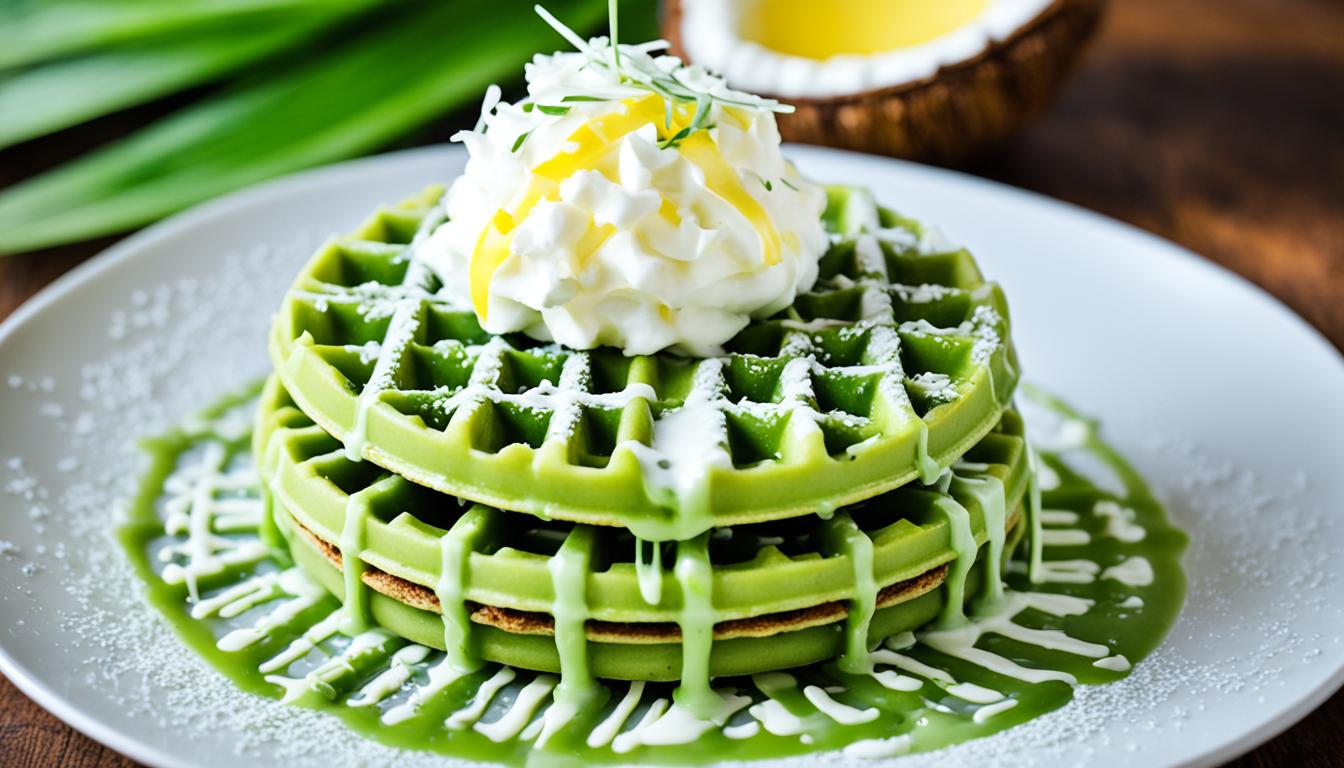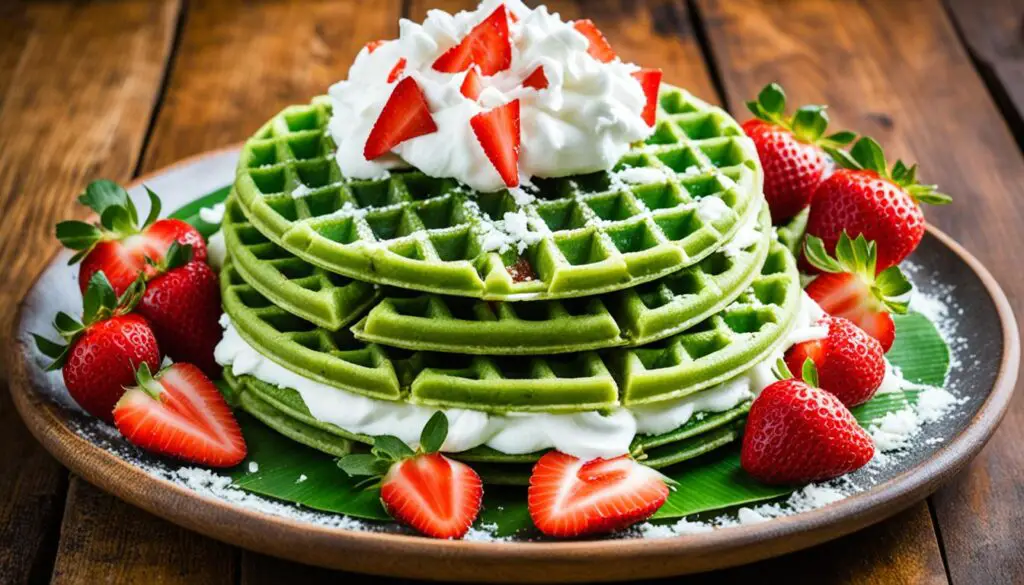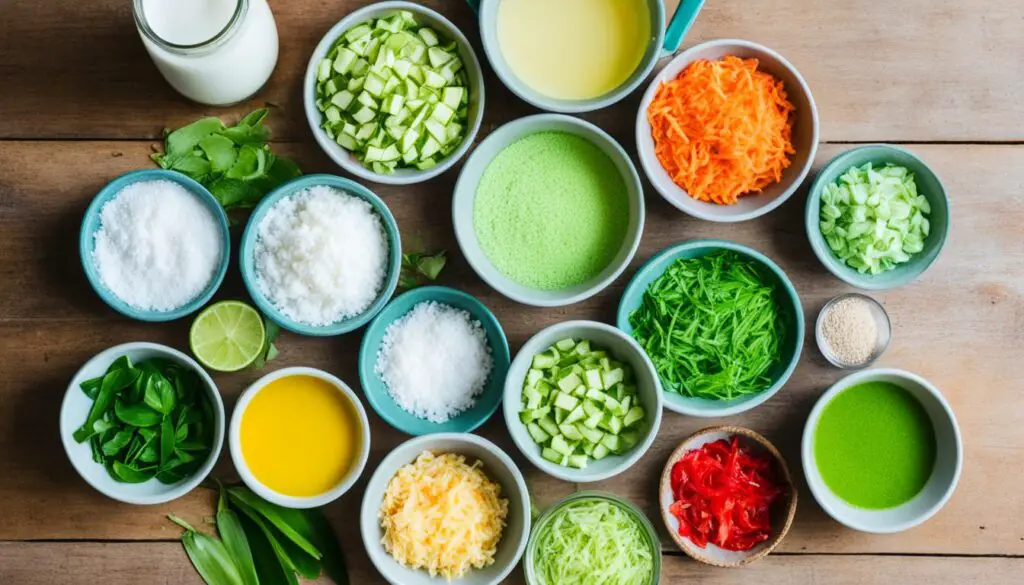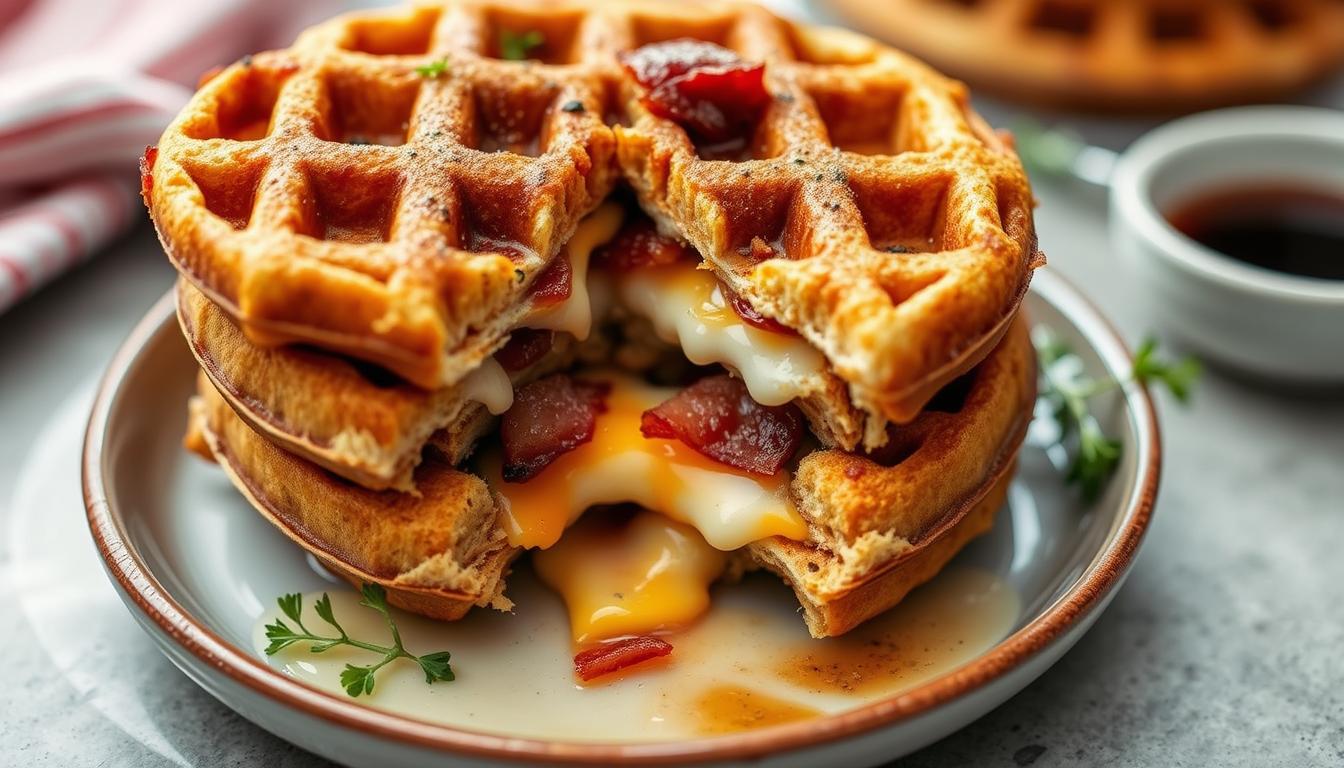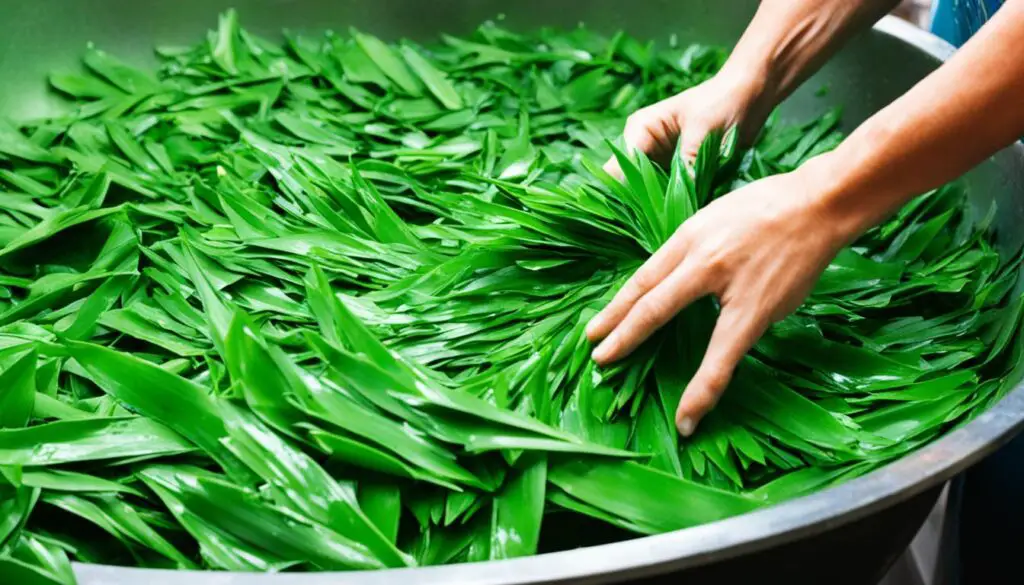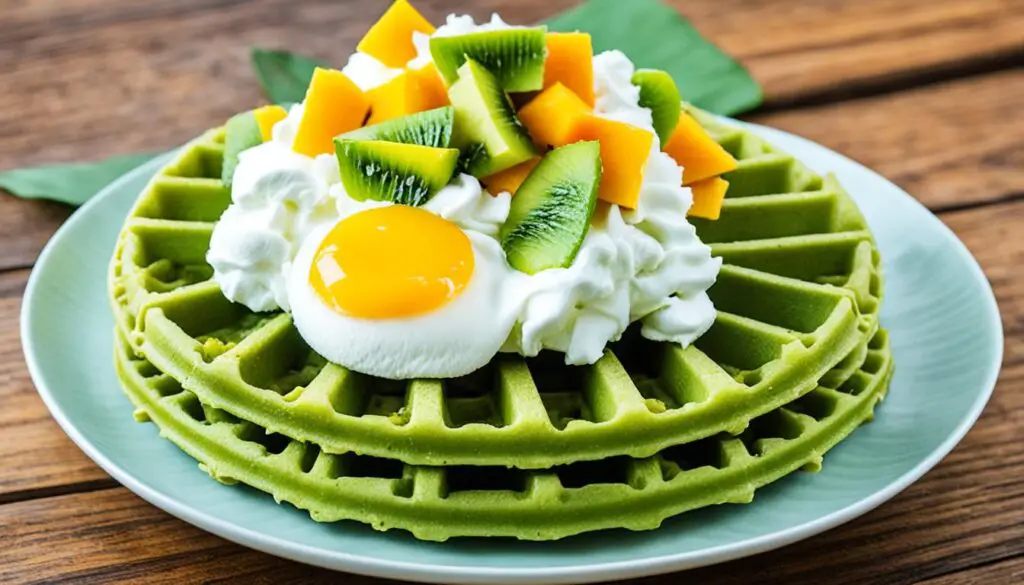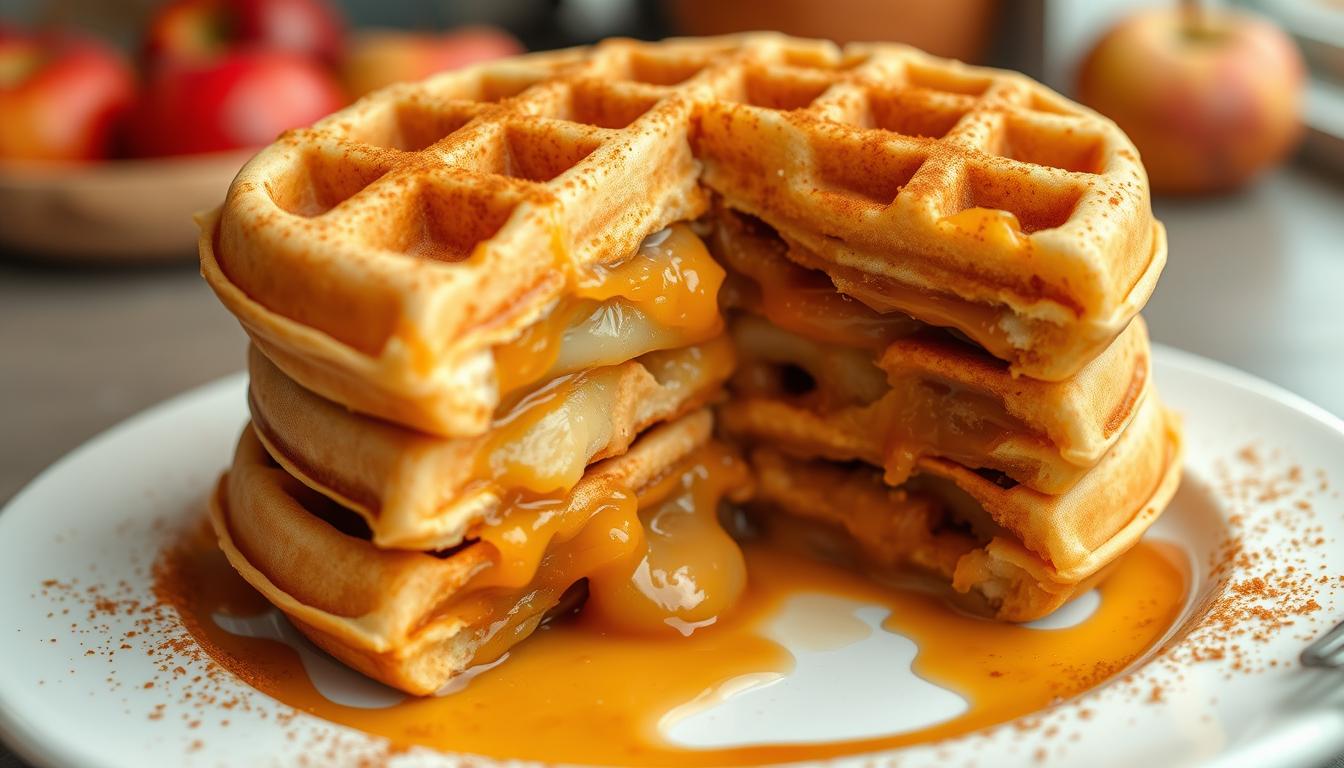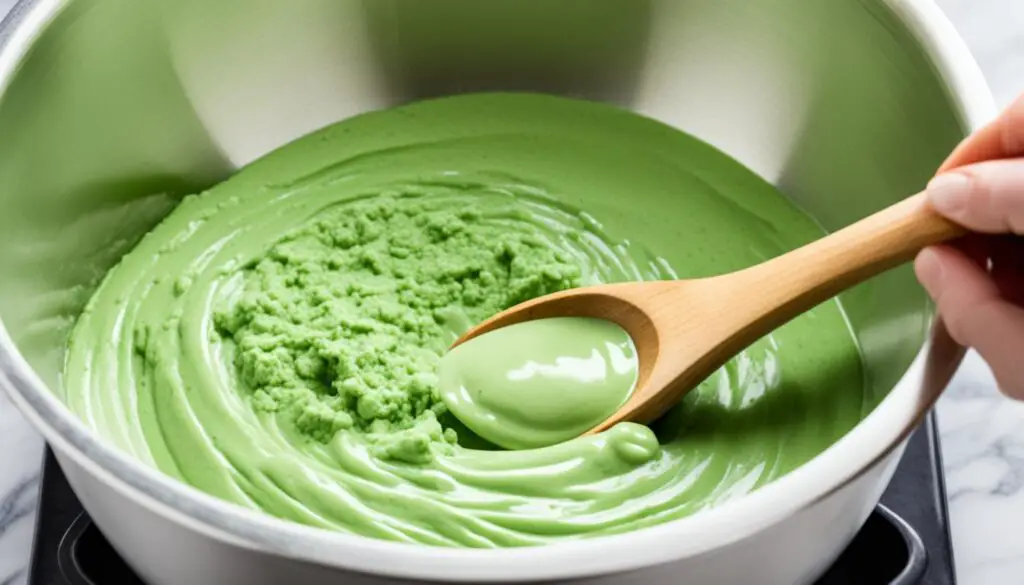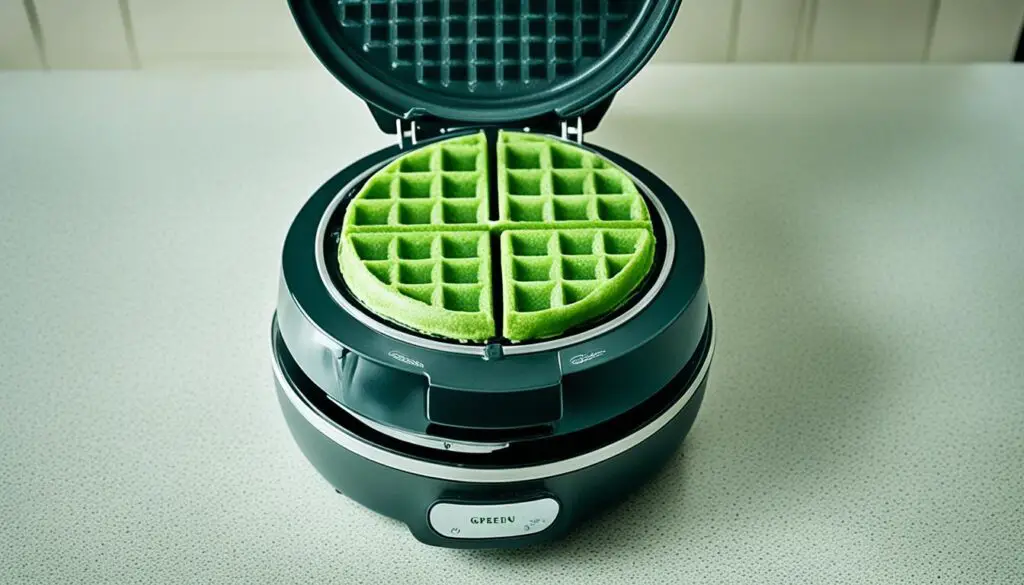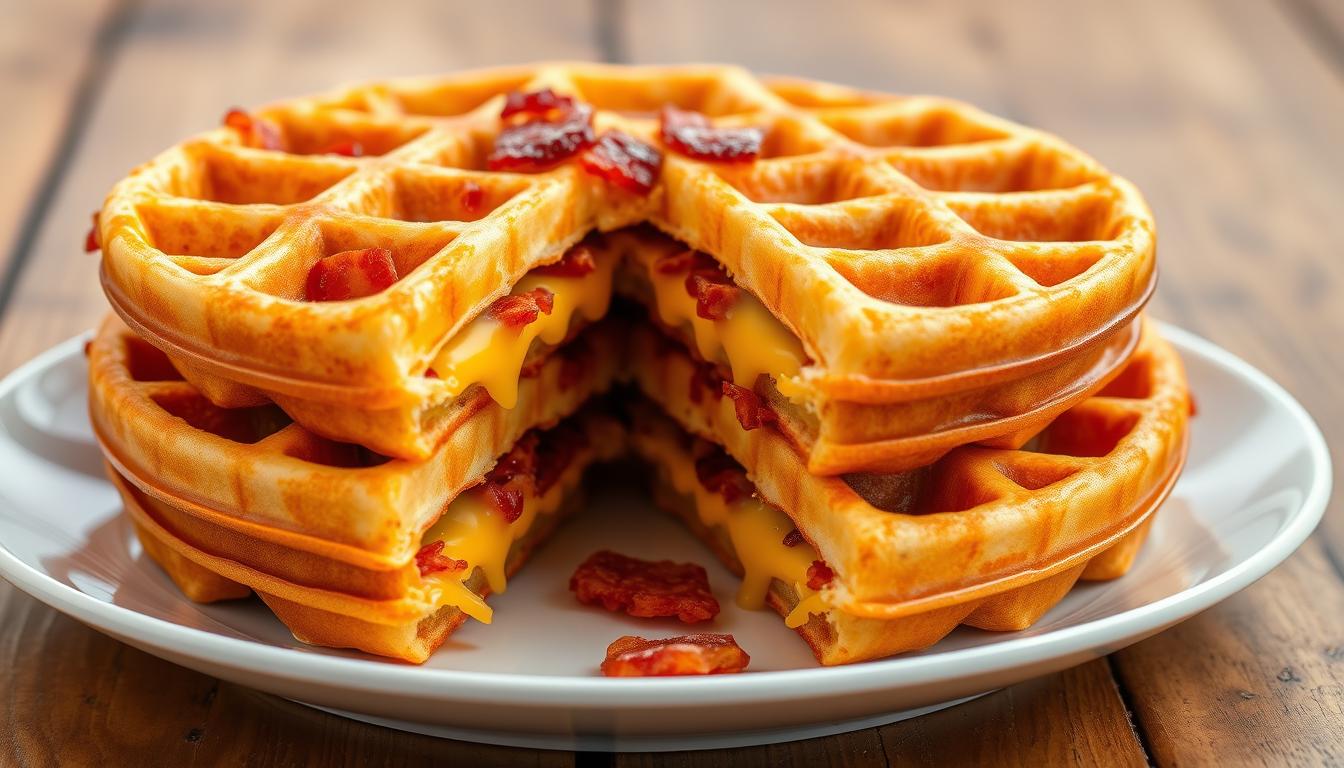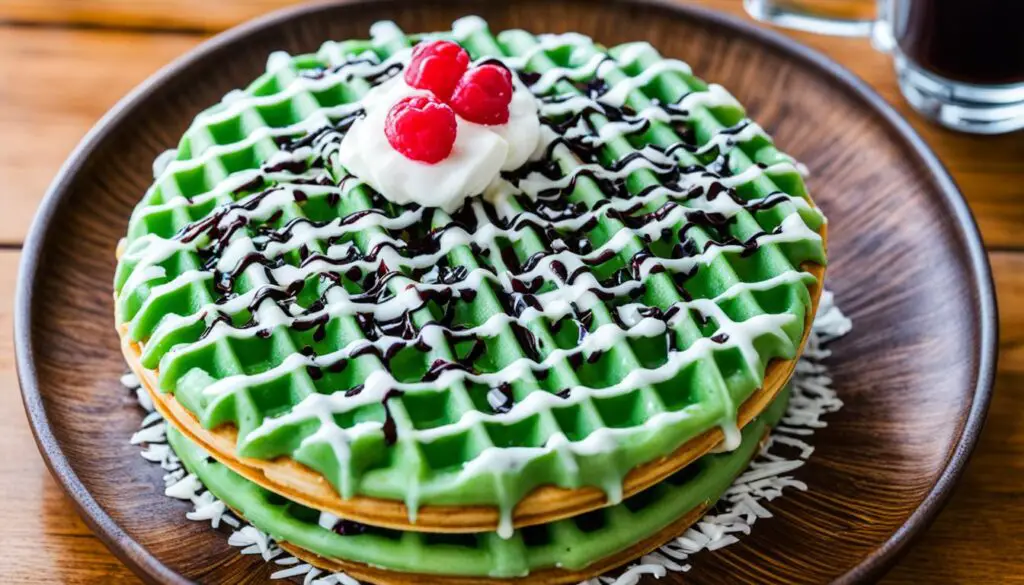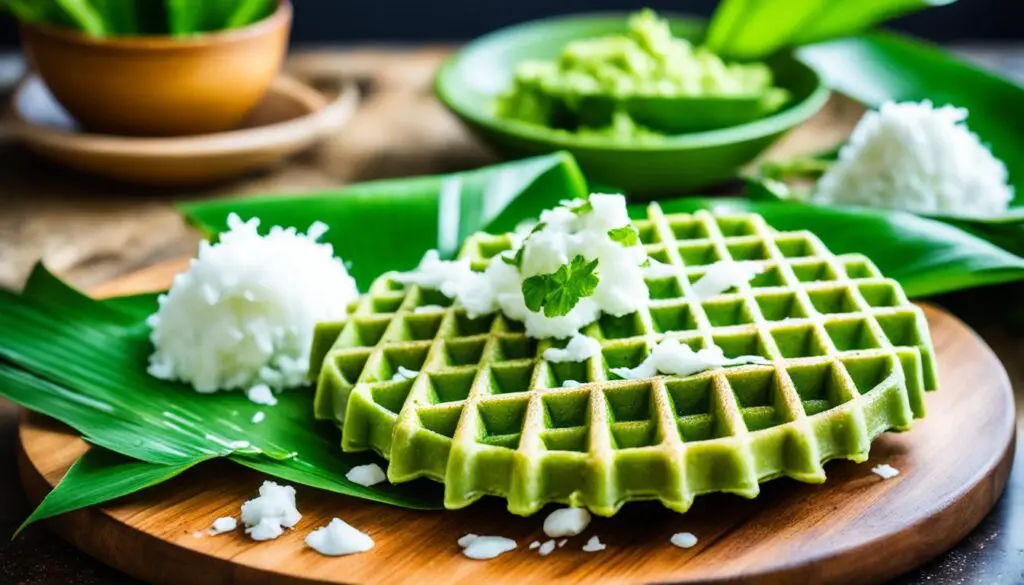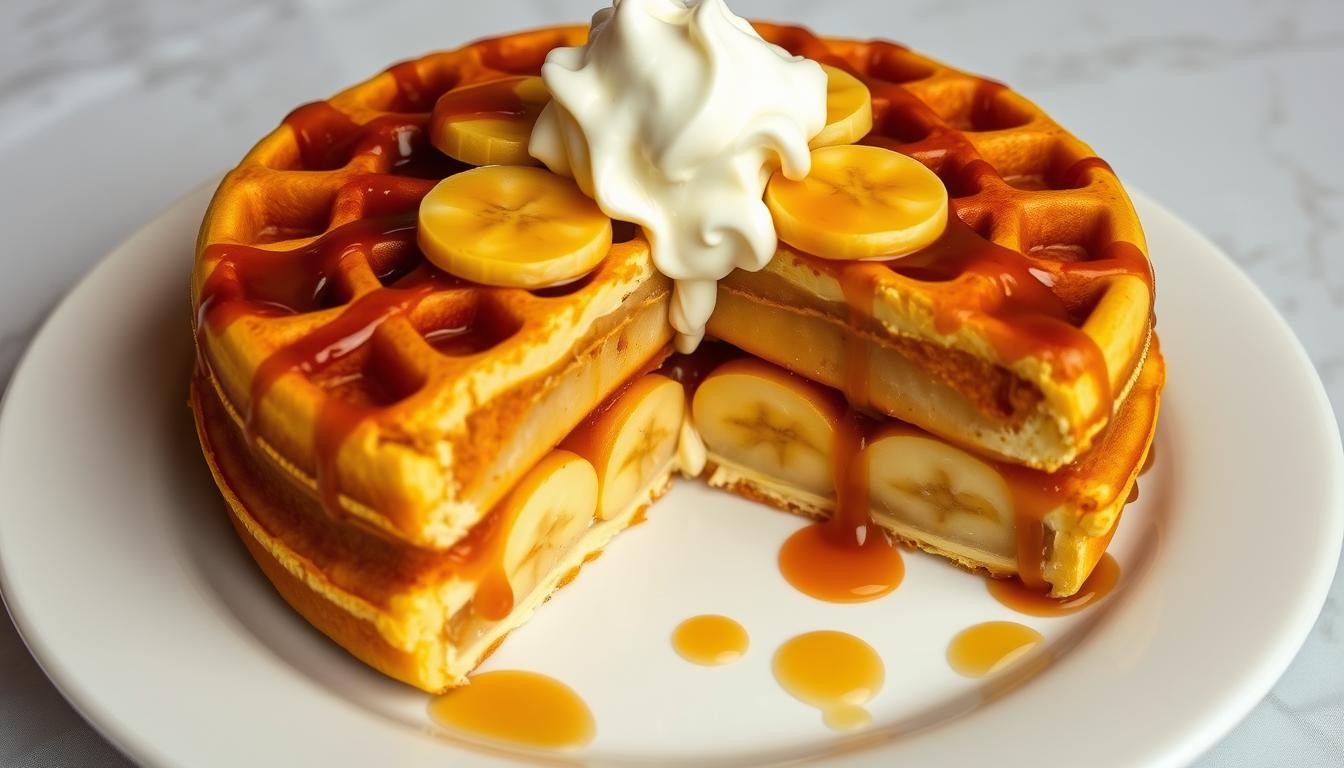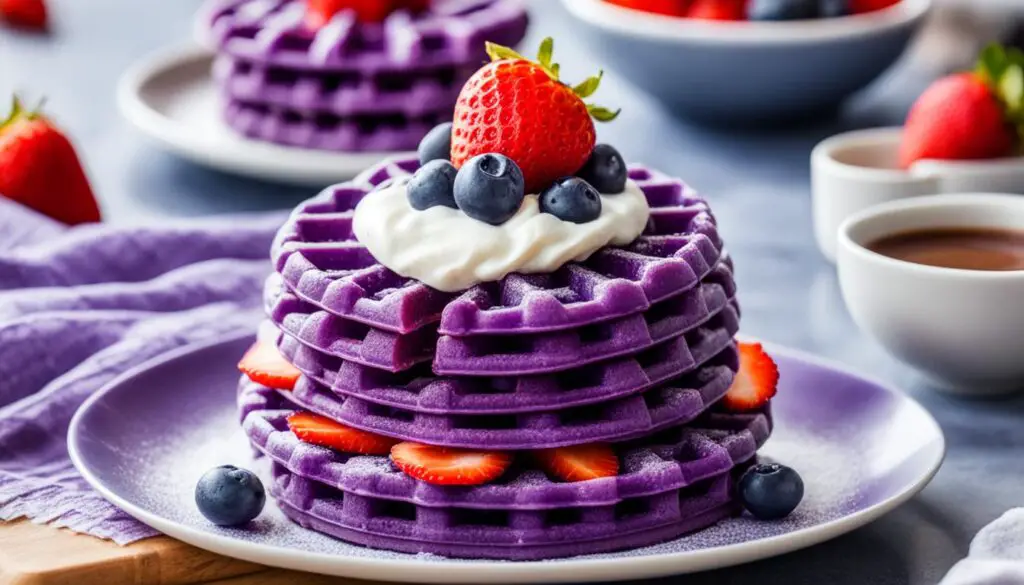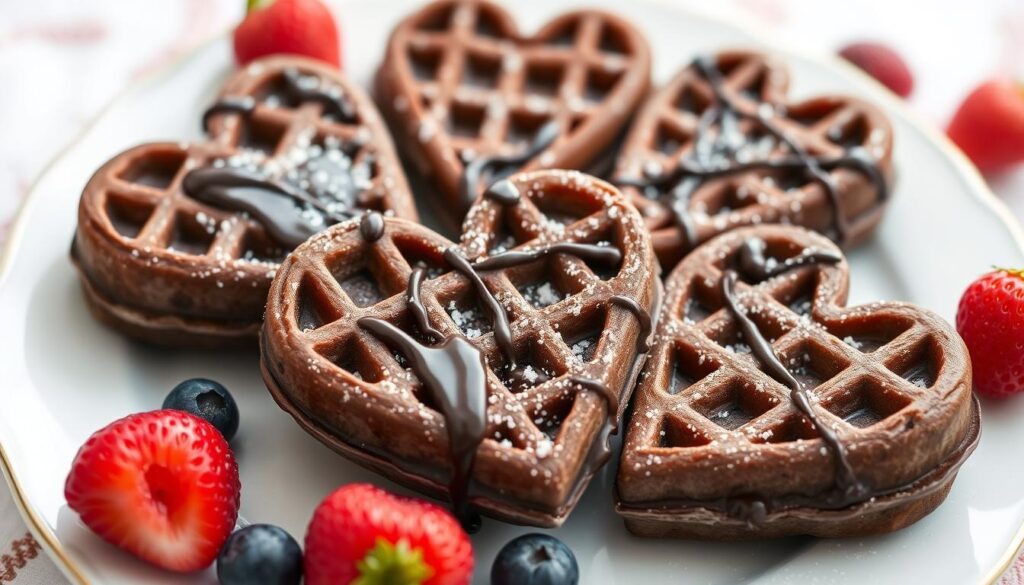Ever wondered why coconut pandan waffles from Vietnam are so loved? These unique waffles hold a key place in Vietnamese cuisine. They come with a special taste and texture, different from the usual American waffles. This article will show you how to make your own Vietnamese waffles at home. You’ll get to taste the wonderful mix of pandan, coconut, and its unique soft inside but crispy outside texture.
So, what’s their secret? Pandan leaves are the star, adding a sweet, fragrant twist. When you mix in rich coconut, you end up with a flavor unlike any other. These Vietnamese coconut waffles are truly special.
Key Takeaways
- Pandan leaves and coconut cream lend a unique flavor profile to these Vietnamese waffles
- The combination of rice flour, tapioca starch, and all-purpose flour creates a chewy mochi-like center and crispy exterior
- Pandan waffles are a beloved street food and dessert item in Vietnam, often sold by vendors using charcoal-heated cast iron molds
- This recipe yields 8 servings of delicious Vietnamese coconut pandan waffles
- Proper techniques, like resting the batter, are key to achieving the perfect texture
Table of Contents
- 1 What Makes Vietnamese Coconut Pandan Waffles Special?
- 2 Ingredients Needed
- 3 Preparing the Pandan Extract
- 4 Vietnamese Coconut Pandan Waffle Recipe for 8 Waffles
- 5 Mixing the Batter
- 6 Cooking the Waffles
- 7 Serving and Enjoying
- 8 Tips for Perfect Pandan Waffles
- 9 Nutritional Information
- 10 Cultural Significance of Pandan Waffles
What Makes Vietnamese Coconut Pandan Waffles Special?
Pandan leaves are key in Vietnamese cooking, adding a sweet smell. They give the waffles a unique flavor. This, with coconut cream, makes them very distinct from normal waffles.
Aromatic Pandan Leaves and Coconut Flavor
These waffles use a mix of rice flour, tapioca, and all-purpose flour. This blend creates a special texture. They are crunchy outside and chewy inside, different from regular waffles.
Crispy Exterior, Chewy Mochi-like Center
In Vietnam, these waffles are a favorite. They’re cooked on the street using special molds over charcoal. This creates a wonderful smell. People enjoy them alone or with ice cream.
Popular Snack and Dessert in Vietnam
Ingredients Needed
To make Vietnamese Coconut Pandan Waffles for 8, you’ll need key ingredients:
Fresh or Frozen Pandan Leaves
Fresh or frozen pandan leaves are the star. They have a sweet, vanilla-like aroma and bright green.
Tapioca Starch
Tapioca starch makes the waffle inside chewy, like mochi.
Rice Flour
Rice flour makes the outside crispy and the inside tender and fluffy.
All-Purpose Flour
All-purpose flour from wheat binds the batter and gives structure.
Sugar
Sugar makes the waffles sweet and helps them brown on the outside.
Baking Powder
Baking powder makes the waffles light and fluffy.
Salt
A pinch of salt boosts the waffles’ overall flavor.
Eggs
Eggs add richness and help the batter keep its shape.
Coconut Cream
Coconut cream gives the waffles a creamy, coconut flavor and texture.
Neutral Cooking Oil
Neutral oil, like vegetable or canola, greases the waffle iron to prevent sticking.
Preparing the Pandan Extract
You can use fresh or frozen pandan leaves to make the extract. If using frozen, remember to thaw them. First, rinse the leaves to get them clean.
Using Fresh or Frozen Pandan Leaves
Cut the leaves into 3-inch pieces. Then, add them to a blender with 1/2 cup of water. Blend until there are no big leaf pieces.
Blending and Straining the Leaves
After blending, pour the mix through a fine-mesh sieve. Press down hard to get all the liquid out. This extract gives your waffles the special smell and taste of Vietnam.
Vietnamese Coconut Pandan Waffle Recipe for 8 Waffles
Are you ready to make Vietnamese Coconut Pandan Waffles that smell amazing and taste delicious? This recipe will help you make enough for 8 people. It only takes about 10 minutes to prepare and 1 hour and 13 minutes to cook.
This recipe uses fresh pandan leaves, tapioca starch, rice flour, all-purpose flour, sugar, baking powder, salt, eggs, and coconut cream. These ingredients are key in giving the waffles their unique taste and texture.
| Ingredient | Quantity | Purpose |
|---|---|---|
| Tapioca Starch | 1 1/2 cups | Provides a chewy, mochi-like texture to the waffle interior. |
| Rice Flour | 1/2 cup | Contributes to the crispy exterior and tender, fluffy interior of the waffles. |
| All-Purpose Flour | 1/2 cup | Helps bind the batter and provides structure to the waffles. |
| Sugar | 1/2 cup | Adds sweetness and promotes browning for a crispy exterior. |
| Baking Powder | 1 tablespoon | Acts as a leavening agent, helping the waffles rise and become light and fluffy. |
| Salt | 1/4 teaspoon | Enhances the overall flavor of the waffles. |
| Eggs | 2 large | Contribute richness, structure, and binding power to the waffle batter. |
| Coconut Cream | 13.5 oz | Lends a creamy, coconut flavor and helps create the waffles’ signature texture. |
| Neutral Cooking Oil | 1 tablespoon | Used to grease the waffle iron and prevent sticking. |
Mixing the Batter
Creating Vietnamese Coconut Pandan Waffles starts with the right batter mix. Blend dry and wet ingredients well for a tasty, airy outcome.
Combining Dry Ingredients
First, mix flour, sugar, cornstarch, salt, baking soda, and powders in a bowl. Add tapioca and rice flour. Whisk these thoroughly for an even mix.
Mixing Wet Ingredients
In another bowl, beat the egg until it gets light and fluffy. Mix in coconut cream, melted butter, and extract. This gives you a creamy, fragrant blend.
Folding Wet into Dry
Combine the wet and dry ingredients with care. Sift the dry mix into the wet one. Use a spatula to fold them together gently. Avoid overworking the mix to keep the waffles light.
Resting the Batter
Let the batter sit for an hour before baking. This wait improves its texture, making the waffles soft and fluffy. You can also keep the batter in the fridge for a week if needed.
Cooking the Waffles
Making Vietnamese Coconut Pandan Waffles is a set process. Start by warming your waffle iron. This makes sure your waffles are well-cooked and crisp on the outside.
Preheating the Waffle Iron
Give your waffle iron a few minutes to heat up before you pour the batter in. This is important to getting your waffles just right. A hot surface makes them cook well and turn crispy outside.
Portioning and Cooking the Batter
After your waffle iron is heated, use a ladle to put the batter in. Make sure you don’t put too much batter. This can make the waffles cook unevenly. Let them cook until they’re a lovely golden-brown, which usually takes 3 to 5 minutes.
Achieving the Perfect Texture
Vietnamese Coconut Pandan Waffles should be crispy outside and soft inside. If yours come out too soft, that’s okay. Put them on a rack for a minute. They’ll get a bit crispier from the heat, balancing their texture perfectly.
Serving and Enjoying
Vietnamese Coconut Pandan Waffles are tasty on their own or with various toppings. You could try whipped cream, fresh fruit, or ice cream. Or, choose decadent condensed milk for a unique flavor boost.
Toppings and Accompaniments
These waffles are very flexible. You can enjoy them with a light dusting of powdered sugar. Or try them with more complex toppings to match their crispy, airy texture.
Reheating and Storing Leftovers
Got some waffles left over? That’s no problem. Store them in an airtight container in the freezer. They’ll keep well for up to 2 months.
To enjoy them again, just reheat in a toaster or oven at 350°F. This will make them warm and crispy like when they were fresh.
Tips for Perfect Pandan Waffles
Follow these tips to make sure your Vietnamese Coconut Pandan Waffles come out great:
Using Fresh Pandan Leaves
For the tastiest waffles, it’s best to use fresh pandan leaves to make extract. If fresh leaves are hard to find, a premium pandan extract works too. Just know it might not be as strong in flavor.
Resting the Batter
Let the waffle batter sit for at least an hour. This makes the waffles light and fluffy. It helps the starches soak up moisture and the gluten to loosen, giving them a nice rise and soft chew inside.
Monitoring Cooking Time
Watch the waffles when they cook. Make sure they’re crispy on the outside but not overcooked inside. Remember, darker waffles are crunchier. Adjust the cooking time to get the texture you like best.
Nutritional Information
While these Vietnamese Coconut Pandan Waffles are undoubtedly a delicious treat, it’s important to consider their nutritional profile. Made with ingredients like coconut cream, tapioca starch, and rice flour, these waffles are likely high in calories and carbohydrates.
The coconut cream used in the recipe provides a rich source of saturated fat and calories from its high coconut oil content. However, it also supplies a good amount of manganese and smaller amounts of iron, magnesium, and copper.
The combination of tapioca starch, rice flour, and all-purpose flour contributes significant carbohydrates, with some fiber from the rice flour. However, these refined starches have a higher glycemic impact compared to whole grains.
On the positive side, the eggs in the recipe provide high-quality protein, vitamins like vitamin D, and minerals like selenium. The pandan leaves, while used primarily for flavor, may also contribute some antioxidants.
So while these waffles should be enjoyed in moderation as an indulgent treat, mindful portion control can help balance their richer nutritional profile.
Estimated Nutrition Information (Per Waffle, assuming 8 servings):
| Nutrient | Amount | %DV |
|---|---|---|
| Calories | 320 | – |
| Total Fat | 18g | 23% |
| Saturated Fat | 13g | 65% |
| Trans Fat | 0g | – |
| Cholesterol | 50mg | 17% |
| Sodium | 180mg | 8% |
| Total Carbohydrates | 38g | 14% |
| Dietary Fiber | 1g | 4% |
| Added Sugars | 4g | 8% |
| Protein | 4g | 8% |
| Vitamin D | 25IU | 125% |
| Calcium | 60mg | 5% |
| Iron | 1mg | 6% |
| Potassium | 120mg | 3% |
Notes:
- Trans fat amount is estimated as 0g since the recipe does not use any hydrogenated/partially hydrogenated oils.
- Dietary fiber is estimated as 1g based on the small amount typically found in rice flour and all-purpose flour.
- Added sugars are estimated as 4g coming from the 1/2 cup (100g) of sugar in the recipe, divided by 8 servings.
Cultural Significance of Pandan Waffles
In Vietnam, pandan waffles, or bánh kẹp lá dứa, are famous. They are a favorite street food and dessert. Sellers make them over charcoal, using special molds. The sweet smells attract everyone around.
Popular Street Food in Vietnam
Pandan waffles are beloved in Vietnam. They are made over coals, giving them a rich flavor. Passersby can’t resist the smell. This way of cooking makes them crispy outside and soft inside.
Influence of French Colonization
The shape of pandan waffles shows France’s impact on Vietnam. Even with Vietnamese flavors, they take after French waffles. This mix makes these treats a symbol of both countries’ food cultures.
